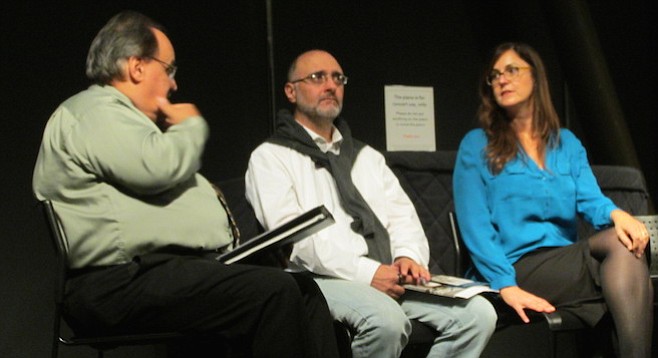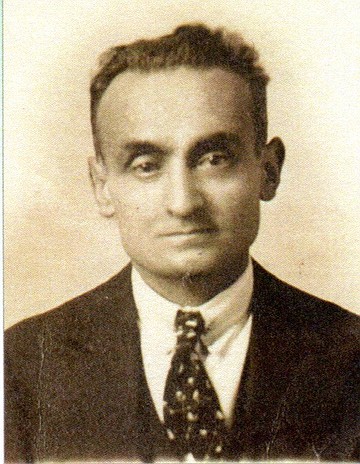 Facebook
Facebook
 X
X
 Instagram
Instagram
 TikTok
TikTok
 Youtube
Youtube

On April 24, 1915, the government of the Turkish Ottoman Empire arrested 250 Armenian intellectual, community, and religious leaders. Most were later killed. It was the start of what would become the 20th Century’s first effort to eliminate an entire ethnic culture. Historians say up to 1.5 million Armenians were exterminated.
Around the U.S., Armenian-American communities organize each year to recognize the atrocities that took place. The L.A. Times reported that over the April 24th weekend tens of thousands of Armenians rallied in front of the Turkish consulate in Los Angeles.
On April 25, a group of 60 filled the community room at the Encinitas Library, as the Intrepid Theater Company performed a reading of the genocide-based play titled Red Dogs Howl. “Dogs” are what the Turks labeled their Armenian citizens when the genocide began.
The 2012 play by Alexander Dinelaris is based around an account of a young American man’s discovery of his Armenian ancestry and his grandmother’s desperate efforts to escape death after witnessing the torture and murder of her husband and nine-month-old daughter.
After the play, three presenters led a panel discussion on the tragedy. Lead actor Jeffery Jones received a round of applause when he revealed that he, too, was of Armenian descent.
Leading the panel was Jack Nalbandian of Oceanside. He has extensively researched the Armenian struggle, based on his grandparents’ fight for survival. His grandfather and his great-uncle, the only ones in their family to survive the onslaught of the Turkish army, fled their village and walked 645 miles to an Armenian community in Jerusalem.
“They survived by throwing themselves on piles of dead bodies and stayed there until nightfall when the Turks left,” said Nalbandian. Along the way, the brothers had to take clothes off the dead to continue their journey.
Armenian-French photographer Bardig Kouyoumdjian shared his 2007 photographic journey back to the area of his ancestors, documenting and photographing the sites in the southern desert, where the Turks force-marched many Armenians, only to perish without food or water.
Kouyoumdjian said he might have the only photographic history of the survivors’ monuments and shrines in that area.
“Since published, ISIS has destroyed all of them. They don’t exist anymore,” he said. (Turkish Armenians were Christians, thus the destruction by ISIS forces in the now-occupied areas along the Iranian and Georgian borders.)

Author Dawn Anahid MacKeen relayed her personal journey. In her 2016 book The Hundred Year Walk, she describes her grandfather’s fleeing to the Euphrates River area, where a Muslim sheik took him in. To research the book, MacKeen walked the same route her grandfather was forced to travel to escape death. She found the family of the sheik who had protected her grandfather.
Nalbandian says that even today, “You can be jailed in Turkey for even mentioning the genocide.”
Panelist said the annual remembrance began on the 50th anniversary in 1965. “We knew our ancestors had dark secrets, but no one talked about it back then,” said Nalbandian, who remembers his grandfather sometimes having a “sad, far away look.”
Nalbandian concluded the session, quoting a line from the play, reminding the audience, “We must never forget. This is what mankind is capable of.” Nalbandian said he thinks continuing to remember, “Speaks to the resiliency of the human spirit; that families go on despite horrible conditions.”
Historical footnote: To date, only 27 countries have formally recognized the Armenian genocide as historical fact. Turkey continues to deny that its former government systematically tried to exterminate its minority population of Armenians, who had lived in the area since 2500 BC. The Turkish Ottoman Empire collapsed in 1923, partially due to its alignment with Germany in WWI.


On April 24, 1915, the government of the Turkish Ottoman Empire arrested 250 Armenian intellectual, community, and religious leaders. Most were later killed. It was the start of what would become the 20th Century’s first effort to eliminate an entire ethnic culture. Historians say up to 1.5 million Armenians were exterminated.
Around the U.S., Armenian-American communities organize each year to recognize the atrocities that took place. The L.A. Times reported that over the April 24th weekend tens of thousands of Armenians rallied in front of the Turkish consulate in Los Angeles.
On April 25, a group of 60 filled the community room at the Encinitas Library, as the Intrepid Theater Company performed a reading of the genocide-based play titled Red Dogs Howl. “Dogs” are what the Turks labeled their Armenian citizens when the genocide began.
The 2012 play by Alexander Dinelaris is based around an account of a young American man’s discovery of his Armenian ancestry and his grandmother’s desperate efforts to escape death after witnessing the torture and murder of her husband and nine-month-old daughter.
After the play, three presenters led a panel discussion on the tragedy. Lead actor Jeffery Jones received a round of applause when he revealed that he, too, was of Armenian descent.
Leading the panel was Jack Nalbandian of Oceanside. He has extensively researched the Armenian struggle, based on his grandparents’ fight for survival. His grandfather and his great-uncle, the only ones in their family to survive the onslaught of the Turkish army, fled their village and walked 645 miles to an Armenian community in Jerusalem.
“They survived by throwing themselves on piles of dead bodies and stayed there until nightfall when the Turks left,” said Nalbandian. Along the way, the brothers had to take clothes off the dead to continue their journey.
Armenian-French photographer Bardig Kouyoumdjian shared his 2007 photographic journey back to the area of his ancestors, documenting and photographing the sites in the southern desert, where the Turks force-marched many Armenians, only to perish without food or water.
Kouyoumdjian said he might have the only photographic history of the survivors’ monuments and shrines in that area.
“Since published, ISIS has destroyed all of them. They don’t exist anymore,” he said. (Turkish Armenians were Christians, thus the destruction by ISIS forces in the now-occupied areas along the Iranian and Georgian borders.)

Author Dawn Anahid MacKeen relayed her personal journey. In her 2016 book The Hundred Year Walk, she describes her grandfather’s fleeing to the Euphrates River area, where a Muslim sheik took him in. To research the book, MacKeen walked the same route her grandfather was forced to travel to escape death. She found the family of the sheik who had protected her grandfather.
Nalbandian says that even today, “You can be jailed in Turkey for even mentioning the genocide.”
Panelist said the annual remembrance began on the 50th anniversary in 1965. “We knew our ancestors had dark secrets, but no one talked about it back then,” said Nalbandian, who remembers his grandfather sometimes having a “sad, far away look.”
Nalbandian concluded the session, quoting a line from the play, reminding the audience, “We must never forget. This is what mankind is capable of.” Nalbandian said he thinks continuing to remember, “Speaks to the resiliency of the human spirit; that families go on despite horrible conditions.”
Historical footnote: To date, only 27 countries have formally recognized the Armenian genocide as historical fact. Turkey continues to deny that its former government systematically tried to exterminate its minority population of Armenians, who had lived in the area since 2500 BC. The Turkish Ottoman Empire collapsed in 1923, partially due to its alignment with Germany in WWI.
Comments